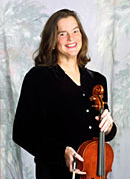Playing For Patients
 Editor's Abstract
Editor's Abstract
Penny Anderson Brill, a violist with the Pittsburgh Symphony, has been developing a music and wellness program for orchestra musicians for the past six years. She has a lot of experience performing in a variety of health care settings.
In this article, Penny shares some tips she has learned over the years while performing for patients in a hospital or other healthcare institution. Her advice ranges from common sense hygiene (wash your hands frequently) to repertoire suggestions and suggestions for talking to individual patients.
Ann Drinan
Musicians frequently donate their time and talent to the community by playing in hospitals and other healthcare settings. This experience can be extremely rewarding, especially if we know what to expect and feel adequately prepared. Below are some tips I’ve picked up over the years – I hope some of them may be useful for you.
If you are sick, don’t show up. (Sick includes sniffles or cough!)
Wash your hands thoroughly and often. Clean the strings and fingerboard on your instrument before arriving and between patients, if they touch the strings. (Use rubbing alcohol, with care not to get it on the varnish. Or the hospital may have sani-wipes you can use.) If you have a CODA bow, clean it (except the bow hair!) as well. If you use a wood bow, you don’t want patients to touch it because you might be spreading germs. Keep your music off the beds and floors. A rolling suitcase for music and stand storage is helpful.
Follow other standard hospital procedures to minimize the spread of infection. (Check with the hospital to see what information they give volunteers regarding this.)
Work with the staff who know the patients (e.g., social workers, child life workers, nurses, support group leaders, recreational therapists, physical or respiratory therapists) to support their goals. Communicate well. Be transparent (i.e., share information).
The staff may be able to tell you ahead of your visit about the patients’ experiences with and preferences in music, so that you can bring that type of music with you. They can also help choose appropriate patients.
Seek advice from a music therapist in designing your program, if you want the optimum interaction with patients. Afterward, review what happened so that the music therapist can help you improve the next interaction. The music therapist must supervise any one-on-one interactions.
Ask for help if you are not sure how to handle a situation, or if you notice something that should be brought to the hospital workers’ attention.
Talk to individual patients/audience before you play and gather information that will determine the music you choose. You are discreetly trying to find out, as appropriate:
- 1. Their state of mind: do they seem agitated, depressed, overwhelmed, or unusually quiet?
- 2. Their age (and therefore what music might have been important during their formative years in HS and college).
- 3. Their background, including experience with music: did they ever play an instrument or sing? What is their favorite music /instrument(s)?
- 4. You might also want to know what brings them to the hospital (don’t ask directly). Are there any other people with them (spouse, siblings, parents, and/or children)? Are they from the area? Do they speak other languages? Is religion important? What else do you notice about them?
- 5. If they are inpatients, what are their goals during this part of their stay: to breathe more deeply in order to avoid pneumonia?; to exercise or do rehab?; to recover from surgery? Are they depressed or anxious? Do they feel isolated?
Your initial music should capture some of the patient’s emotional state at that moment. You might start with more active music and transition to slower, calmer, more optimistic and/or supportive music, if that is the goal for a particular session. Or play the same piece, gradually slowing down. (Of course for rehab it may at times be appropriate to play increasingly energizing music!) If patients are feeling isolated or disoriented, songs (religious, oriented to time of year or associated with positive memories) and interactive/socializing music may help. Be aware that what works for you might not work for them: they may have negative associations with a piece of music that is your favorite! Something you consider restful may have associations or memories that are emotionally draining for the patient. Even the same person will have different music preferences as their needs change. Ideally, the music therapist will design the appropriate plan for the session and can work with you on selecting music.
Making up words to a song or making up a song with the patient is sometimes appropriate, but is best done over time by a music therapist or other staff person who sees the patient frequently.
Other suggestions:
- 1. Listen to the needs of your audience. If the pieces you intended to play are not appropriate, don’t play them. If your instrument is not a good choice, don’t use it: use your voice, percussion instruments, or motions instead, as needed.
- 2. Be flexible. Be creative.
- 3. Know when to stop.
- 4. Wear comfortable shoes and clothes. Bright or calming colors are good.

Leave a Comment: